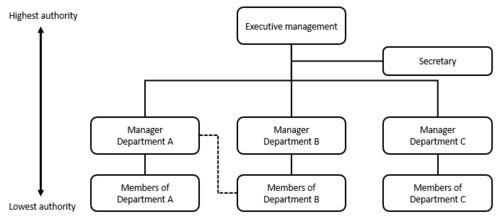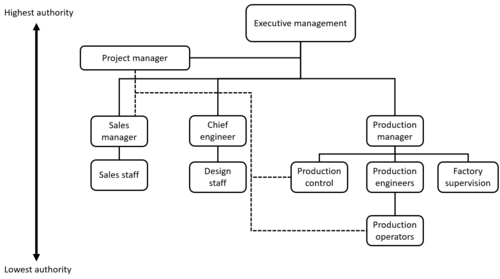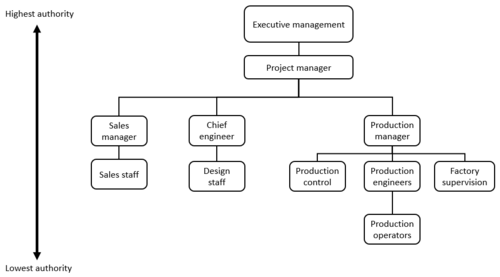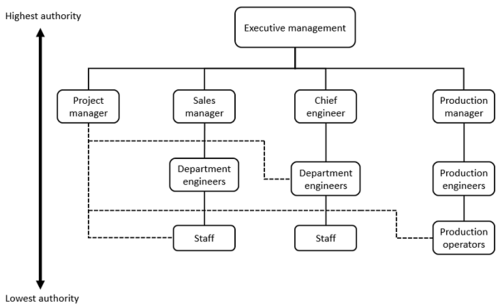Project organization
Written by Marcus Christiansen.
Abstract
Project organization is a term referring to the structure of a project throughout its entire lifecycle, and its purpose is to define a structure of responsibilities and accountability across the project team [1]. An effective establishment of a project organization is characterized by communicated clear lines of authority and appropriately assigned roles between the project employees with the associated responsibilities. This clarity of the project structure implies an improved alignment of the project goals with the project activities executed by the employees, which leads to an increase of the operating efficiency and hence an increase of the overall performance [2]. Neglecting efficient organization of projects often leads to lack of motivation, which causes schedule overruns and hence budget overruns [3]. Consequently, well planned project organization and maintaining it during the project is essential to the success of the project [4]. The modern and commonly acknowledged way to establish an effective project organization is to create an organization chart [2] [5].
This article examines the state-of-the-art applications of project organization as well as hands-on guidance describing how to apply the best practices. The application section is divided into three subsections characterizing the commonly used types of organization charts in recent time. These sub-sections explain the organization chart types in detail and in which context each of them are applicable as well as their respective advantages and disadvantages. Ultimately, this article contains a limitations section discussing organization charts, organization of projects in an agile project management environment, and how the future organizational hierarchy trend might threaten the applicability of organization charts.
Contents |
Big idea
Project organization is a term describing the structure of a project throughout its entire lifecycle based on communication, coordination and management. The purpose of project organization is to define a structure of responsibilities and accountability across the project team [1]. Therefore, an effective establishment of a project organization requires unambiguously communicated authority. Additionally, each project team member should know their specific role along with its associated responsibilities. This decrease of uncertainty about responsibility and accountability will reduce the risk of conflict emergence between employees, which implies an increase of the operating efficiency and hence an increase of the overall performance. Also, effective project organization enhances the coordination within the project team through communication of clear lines of authority. This clarity of project roles improves the alignment of project activities executed by the employees with the overall project goals [2]. Furthermore, a well-defined project organization establishes common expectations among the project team members, which entails a united project team work to achieve the desired project objectives. Neglecting efficient organization of projects often leads to lack of motivation, which causes schedule overruns and hence budget overruns [3] . Accordingly, well planned project organization and maintaning it during the project is essential to the success of the project [4].
State of the art
The commonly acknowledged way to establish an effective project organization is to create an organization chart, which also is referred to as an organizational breakdown structure chart [2] [5]. Organization charts vertically represent the role and authority of each organization member. The status and authority decreases from top to bottom of the chart, which means the most powerful member organizational role is located in the top of the chart. An example of an organization chart is given in Figure 1. This tool is very powerful to demonstrate and clearly communicate the authority and roles within projects. Additionally, it emphasizes the context of the project internally in the organization. This can further be useful to communicate the organizational project governance structure along with interdependencies between the specific project and other projects and/or programs of the organization [3].

Application
To ensure success of the project as a project manager, efficiently establishing a project organization is essential. However, since project managers tend to work in large organizations with many employees, it is redundant to create an organization chart involving the whole organization with all its associated nuances and politics. Therefore, it is recommended that project managers focus only on the people having influence on activities of the project while creating project organization structures.
Before initiating the creation of an organization chart, several different aspects are important to consider.
First of all, it is significant to consider what roles that need to be assigned within the project team to achieve the defined objectives. The term role refers to a specific function assigned to an individual.
Since the project team roles identify the functions needed to make the project a success, it is important to determine which competences that are associated with each role. When the identification of desired competences is executed, the roles are assigned to individuals from the organization. However, sometimes it is required to hire people to acquire the optimal competences if these are not already obtainable within the organization.
Assigning the roles to the right people implies assigning the responsibility associated with the roles. The individuals fulfilling their roles are accountable for the completion of the project activities related to their role of the project.
The authority over the project might already be determined and distributed between the project manager and their managers [6]. In traditional project management, this would often be the case where the project manager primarily made the important decisions, managed deliverables and applied resources. However, today's project management is highly influenced by an agile approach. In this environment, the management style is rather participative than authoritarian. This implies that the management of the project team members is built on trust, which means that project activities decisions are made progressively by the project team members themselves [4]. Hence the authority over the project is more divided between the project team members in agile project environments.
Creating an organization chart
Ultimately, the organization chart of the project will be associated with the overall structure of the company regarding division of authority and roles. Therefore, if the organization in which the project takes place already has an organization chart, it is advantageous to either draw inspiration from that or create the organization chart of the project directly on the one made by the company. Nevertheless, the organization chart should be designed in the simplest possible way so it is easily interpretable [2].
Assuming the required roles within the project team are fulfilled, each role is supposed to be indicated as a box containing the function and the name of the employee. By convention, the function of an employee is supposed to be the job title. The boxes are then arranged with regard to authority, where the most powerful role of the project is placed at the top. As illustrated in Figure 1, the manager of Department A is above the members of Department A. If this department e.g. represented a project team, the project manager would be the manager of Department A, while the project team would be represented as boxes below the project manager. Usually in case of smaller projects, the project team members are represented with equal authority, i.e. they are placed side-by-side horizontally. However, large projects often tend to deviate from this flat structure due to the increasing amount of employees. Accordingly, the authority is distributed further within the project team, and this implies more layers of authority below the project manager. The solid lines illustrated in Figure 1 demonstrates lines of command. Downwards, the lines indicate who the employee can give commands to. Upwards, the lines indicate who the employee has to report to. Dotted lines between employees demonstrate appointed lines of communication or reporting. E.g. in Figure 1, the manager of department A might have to communicate with the members of Department B for some specific reason, and this would then be indicated by a dotted line. However, the dotted lines are not always implemented in organization charts. Finally, staff roles such as the Secretary in Figure 1 have no direct authority. Nevertheless, by supporting their manager, they exploit the authority and status of their manager [3].
There exist a broad range of different types of organization charts based on the terms and definitions specified above. The organization chart types that define the current standards and hence are the most common in practice are staff line project organizations, project team organizations and matrix organizations [7]. Before initiating the creation of an organization chart in practice, it is important to consider which of the following types are most suitable due to their characteristics and appropriate applications. Then inspiration can be drawn from the information and examples below.

Staff Line Project organizations
A staff Line Project organization [7] is an organizational structure that is used when a project is executed within an organization alongside its regular manufacturing activities. Consequently, the original line of command of the organization and its authority is allowed to continue normally parallel to the project execution. However, this implies that the project manager has no authority over any manager or their staff, and thus the project manager does not have a fixed project team. Accordingly, the project manager must have high skills in dealing with people along with skills in motivation and reasoning. An example of a staff line project organization is illustrated in Figure 2.
In case conflicts arise and the project manager fails to resolve the matter, the project manager has the opportunity to seek support from the senior management. Hence the project manager can obtain the power needed to accomplish the needed changes to achieve the desired project objectives. This use of the management's authority is equivalent to how the secretary in Figure 1 acquires authority in certain situations [3].
The advantages of using a staff line project organization are:
- "The organizational structure will not be changed
- The project organization can be set up and dissolved again quickly
- Project staff remain in their departments and can draw their expertise from there" [7]
The disadvantages of using a staff line project organization are:
- "The project manager has no direct right to issue instructions
- Coordination is very time-consuming
- Measures are often difficult to enforce" [7]
Staff line project organizations are most applicable in either non-critical and smaller projects or strategic and cross-departmental projects [7].

Project team organization
In case a project has its individual autonomous unit within an organization, the organization chart of the project is defined as a project team organization (also called pure project organizations or autonomous project organization). The role of the project manager of this project organization is completely opposite to their role in project team organizations. In project team organization charts, the project manager is located on top of the autonomous project unit, which implies the project manager has a direct line of authority over all project employees. Hence the project manager is accountable for all specialized project aspects alongside the traditional activities of work allocation, planning and progressing. Such an organizational chart is shown in Figure 3. The example demonstrates a project as an individual and autonomous unit within the organization due to its organized departments, which respectively are accountable for their own industrial disciplines required to achieve the desired project objectives. Since the project manager has complete responsibility over all project aspects, communication between technical practices and motivation of employees across departments are easier to achieve for the project manager [3].
The advantages of using a project team organization are:
- "High identification of the project staff with the project
- Clear structures and both technical and disciplinary right of instruction by the project manager
- Direct communication" [7]
The disadvantages of using a project team organization are:
- "High effort for reintegration of project staff into the line organization
- Knowledge exchange with specialist departments [is] difficult" [7]
Project team organizations are most applicable in either time-critical, large or international projects [7].

Matrix organizations
A matrix organization is the most applied project organization and is structured as a combination of both the staff line project organization and project team organization. An example of a matrix organization is shown in Figure 4, which indicates that the project manager does not have completely direct authority over the project staff that are specialists of their respective departments. However, in this type of project organization, the project manager partially has authority over the project employees, since they are available to the project in different fractions of their time in. Due to this constellation of their working hours, they report both to their department manager and the project manager. This can cause conflicts regarding whether to prioritize tasks for the project or the department, which implies communication is crucial to succeed in this project organization.
The advantages of using a matrix organization are:
- "Employees remain in their departments, so that reintegration after the end of the project is not necessary.
- Employees can benefit from the knowledge and exchange in their specialist department
- Flexible access to resources" [7]
The disadvantages of using a matrix organization are:
- "Conflicts between project and department management [are] possible (employees have two superiors)
- Problems with prioritization between line and project work" [7]
Matrix organizations are most applicable in either deadline-critical or medium to large projects [7].
Limitations
Organization charts
Despite organization charts are very effective to communicate organizational structure and division of authority, they are illustrated by vertical lines of communication. In practice, communication is far more complex due to informal communication across the organization. Hence this tool is mostly applicable to emphasize organizational structure and its responsibility division rather than constraining the organizational communication [3]. For instance using Figure 1 above, the manager of department C could be using the members of department A as consultants temporarily. In that case, the members of department A will occasionally report to the manager of department C instead of the manager of department A. Therefore, organization charts are effective foundation for project organization but not necessarily for strictly defining organizational communication.
Due to organizational changes or new projects arising, it is advantageous to create new organization charts. However, the resulting organizational change of status or authority can cause unexpected reactions from people. Some people may feel they are not appreciated as important employees, and an organizational feeling of injustice can arise [3]. A potential solution is to distribute updated organization charts with a thorough explanation and enable employees to express their feelings and thoughts through open communication.
Organization charts typically only show the role of the project team member and not the specific assigned responsibilities. To emphasize the assignment of project tasks to individuals or teams within the overall project team, a Responsibility assignment matrix is suitable to apply. An effective way of doing this is to construct and implement a RACI matrix, which describes different categories of responsibility assignment [6].
Project organization in an agile project management environment
In the modern business society characterized by rapid project execution, it can be difficult to develop a comprehensive project organization due to the lack of available information in the beginning of projects. Because of this continuously increasing uncertainty, it is beneficial to manage projects in an agile environment.
Despite that today's project management is heavily dominated by an agile approach, the traditional practice of project organization is still essential to achieve the desired objectives of a project. Informally built on a dynamic and fluid approach, agile project management experiences difficulties without any implementation of traditional project management practices [4]. Hence, even in an agile project management environment, project organization creates a structured project management foundation. Consequently, the uncertainty related to responsibility and accountability is minimized as much as possible. Implementing this traditional project management practice will complement the agile approach by ensuring everyone knows their assigned responsibility. This makes more room for the project team to navigate smoothly in the agile project management environment and focus on the right things.
Fluid hierarchies of the future threatens the applicability of organization charts
According to Bob Johansen who has helped organizations worldwide to predict and act upon the industrial future over 40 years, static hierarchies characterized by clear lines of command and authority will no longer exist within the next decade. Instead, a remarkable decentralization will materialize representing mass participation of employees. He emphasizes this by claiming "hierarchies won't be controllable[8]". This entails decision-making power and thus authority are distributed almost equally, which would eliminate the applicability of traditional organization charts. An extreme case of this future fluid hierarchy is an organizational structure almost completely without managers and departments, in which employees independently prioritize and organize their workstreams as well as daily tasks. However, this potential future organization of accountability and responsibilities of the employees only works in case everyone shares the same organizational direction and values [8]. It seems difficult to ensure that everyone pursues the organizational vision and objectives without managers, whose main function is to align the work of their departments' employees with the organizational strategy. Maintaining the presence of managers and hence the static hierarchy to some extent appears necessary to align organizational activities with the overall strategy, which indicates the continuous significance for centralization within organizations. This emphasizes that hierarchies is set to survive for some time yet, which indicates a continuous applicability of organization charts.
References
- ↑ 1.0 1.1 A. (2017). Managing successful projects with prince2 2017 edition. The Stationery Office Ltd.
- ↑ 2.0 2.1 2.2 2.3 2.4 Thakkar, J.J. (2022). Project Organization. In: Project Management. Management and Industrial Engineering. Springer, Singapore.
- ↑ 3.00 3.01 3.02 3.03 3.04 3.05 3.06 3.07 3.08 3.09 3.10 D. Lock, Project Management. 10th edn., (Gower Published Limited, 2013), pp. 131–154.
- ↑ 4.0 4.1 4.2 4.3 Kerzner, Harold. (2017). Project Management: A systems approach to planning, scheduling, and controlling - Section 11.8 and 8.12. 12th ed. Wiley.
- ↑ 5.0 5.1 Project Management Institute, Inc. (PMI). (2021). A Guide to the Project Management Body of Knowledge (PMBOK ® Guide) – 7th Edition and The Standard for Project Management - Section 2.2.1 and 3.2. Project Management Institute, Inc. (PMI). Sections respectively retrieved from https://app.knovel.com/hotlink/pdf/id:kt012LZGJB/guide-project-management/project-team-management and https://app.knovel.com/hotlink/pdf/id:kt012LZF39/guide-project-management/create-collaborative (Accessed: 12 February 2023)
- ↑ 6.0 6.1 Gary L. Richardson and Brad M. Jackson. 2018. Project Management Theory and Practice - Section 17.1, Third Edition (3rd. ed.). Auerbach Publications, USA.
- ↑ 7.00 7.01 7.02 7.03 7.04 7.05 7.06 7.07 7.08 7.09 7.10 7.11 Witte, F. (2022). Project Organization. In: Strategy, Planning and Organization of Test Processes. Springer, Wiesbaden.
- ↑ 8.0 8.1 Johansen, B. (2020), BROADER SPECTRUMS OF HIERARCHY: NEW ANIMATED ORGANIZATION CHARTS. Leader to Leader: 27-32.
Annotated bibliography
- D. Lock, Project Management. 10th edn., (Gower Published Limited, 2013), pp. 131–154.
The book written by Dennis Lock provides a comprehensive description of project management's practices and principles, which demonstrates the acknowledged processes of project management. Covering the significant aspects of project management altogether, the book provides an exhaustive framework to execute projects successfully. Even though the book was published a decade ago, it still covers the fundamental aspects of the commonly acknowledged types of organization charts. Thus page 131-154 of the publication was applied to describe the key elements and practices of organization charts along with an explanation why the tool is remarkably applicable. Also, the book was used to explain the different kinds of organization charts, despite the fact that the names of the charts do not correspond with the names presented in the newer used publications. Ultimately, the book was applied to discuss the limitations of organization charts in general.
- Witte, F. (2022). Project Organization. In: Strategy, Planning and Organization of Test Processes. Springer, Wiesbaden
Examining software testing projects, this book covers the essential steps of planning and conception necessary to execute successful projects. It provides a broad explanation of all aspects of procedures and processes associated with tests and testing projects, and it ends with exhaustive chapters concerning test methods, test organization in agile projects and testing in an environment of artificial intelligence. The Project Organization chapter of the publication was initially applied as a particularly recent source to investigate what the acknowledged ways to organize projects are that belong to the current and best practices. Additionally, the book provided a comprehensive description of the three identified project organization types along with their respective area of application as well as advantages and disadvantages.
- Project Management Institute, Inc. (PMI). (2021). A Guide to the Project Management Body of Knowledge (PMBOK ® Guide) – 7th Edition and The Standard for Project Management
The PMI standard presents the fundamental aspects to understand and execute project management successfully along with explanations about systems in which projects operate within. It provides descriptions of project management principles and project performance domains, which collectively define the requirements for the best project management practices. Also, the publication contains a chapter about project tailoring along with commonly acknowledged models, methods and artifacts. The PMI standard was applied to determine what the commonly acknowledged way to establish an effective project organization is.
- Thakkar, J.J. (2022). Project Management. Management and Industrial Engineering. Springer, Singapore.
This book delves into the complex field of operational and strategic difficulties when managing projects, and it covers qualitative and quantitative practices to examine these key issues of project management. To equip project managers appropriately to deal with these problematic topics, the book provides detailed studies of and frameworks concerning communication, procurement, scheduling and risk management. Since the book was published recently, its Project Organization chapter was applied to determine the characteristics and essence of project organization in the Big Idea section. Additionally, it was used to identify what the recent best practices of organizing projects are in the State of the art section. Ultimately, it was applied to briefly introduce the basics in the section concerning creation of organization charts.
- Johansen, B. (2020), BROADER SPECTRUMS OF HIERARCHY: NEW ANIMATED ORGANIZATION CHARTS. Leader to Leader
This article discusses the role and shift of organization charts in the future, which is claimed in the article to be characterized by an absence of hierarchies. This implies there will be a constant reassessment of who is in the best position to make decisions at what time, which entails the traditional distribution of authority in organizations will fade away. Page 27-32 of this publication was used to discuss the future and applicability of organization charts, since the article states that the conventional chain of command in organizations will disappear within the next decade.